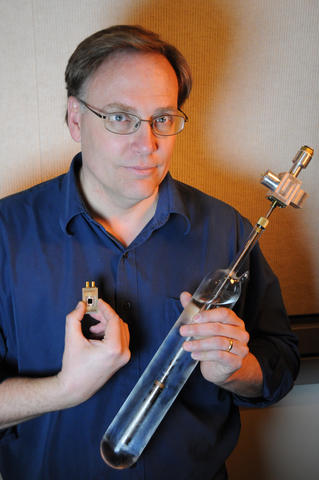
NIST physicist Samuel Benz holds the two components that are compared in the first electronic measurement of the Boltzmann constant. The ac reference signal generated by the superconducting chip (left) is compared to the "Johnson noise" of a resistor inside the glass container (right). In the experiment, the water in the container is held at its triple point temperature near 0° C or 32° F.
Researchers at the National Institute of Standards and Technology (NIST) have for the first time used an apparatus that relies on the "noise" of jiggling electrons to make highly accurate measurements of the Boltzmann constant, an important value for many scientific calculations. The technique is simpler and more compact than other methods for measuring the constant and could advance international efforts to revamp the world's scientific measurement system.
The Boltzmann constant* relates energy to temperature for individual particles such as atoms. The accepted value of this constant is based mainly on a 1988 NIST measurement performed using acoustic gas thermometry, with a relative standard uncertainty of less than 2 parts per million (ppm). The technique is highly accurate but the experiment is complex and difficult to perform. To assure that the Boltzmann constant can be determined accurately around the world, scientists have been trying to develop different methods that can reproduce this value with comparable uncertainty.
The latest NIST experiment used an electronic technique called Johnson noise thermometry (JNT) to measure the Boltzmann constant with an uncertainty of 12 ppm. The results are consistent with the currently recommended value for this constant. NIST researchers aim to make additional JNT measurements with improved uncertainties of 5 ppm or less, a level of precision that would help update crucial underpinnings of science, including the definition of the Kelvin, the international unit of temperature.
The international metrology community is expected to soon fix the value of the Boltzmann constant, which would then redefine the Kelvin as part of a larger effort to link all units to fundamental constants. (See "'Sí' on the New SI: NIST Backs Proposal for a Revamped System of Measurement Units.") This approach would be the most stable and universal way to define measurement units, in contrast to traditional measurement unit standards based on physical objects or substances. The Kelvin is now defined in terms of the triple-point temperature of water (273.16 K, or about 0 degrees C and 32 degrees F), or the temperature and pressure at which water's solid, liquid and vapor forms coexist in balance. This value may vary slightly depending on chemical impurities.
The NIST JNT system measures very small electrical noise in resistors, a common electronic component, when they are cooled to the water triple point temperature. This "Johnson noise" is created by the random motion of electrons, and the signals they generate are directly proportional to temperature. The electronic devices measuring the noise power are calibrated with electrical signals synthesized by a superconducting voltage source based on fundamental principles of quantum mechanics. This unique feature enables the JNT system to match electrical power and thermal-noise power at the triple point of water, and assures that copies of the system will produce identical results. NIST researchers recently improved the apparatus to reduce the statistical uncertainty, systematic errors and electromagnetic interference. Additional improvements in the electronics are expected to further reduce measurement uncertainties.
The new measurements were made in collaboration with guest researchers from the Politecnico di Torino, Italy; the National Institute of Metrology, China; the University of Twente, The Netherlands; the National Metrology Institute of Japan, Tsukuba, Japan; and the Measurement Standards Laboratory, New Zealand.
* The currently accepted value of the Boltzmann Constant is 1.380 6504 x 10-23 joules/kelvin.
S.P. Benz, A. Pollarolo, J. Qu, H. Rogalla, C. Urano, W.L. Tew, P.D. Dresselhaus and D.R. White. An electronic measurement of the Boltzmann Constant. Metrologia. Published online March 30, 2011.

